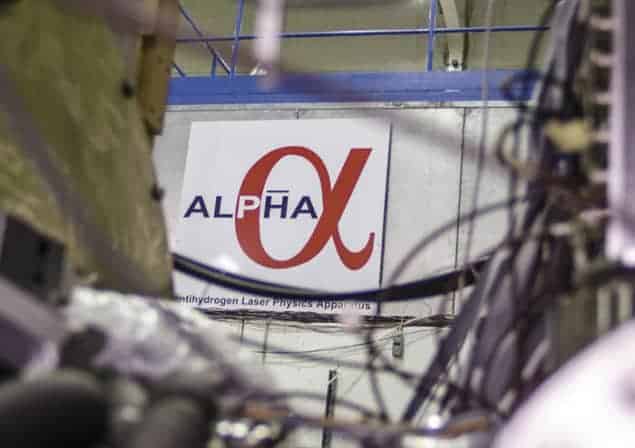
The first spectroscopy measurements of an atom of antimatter have been made by an international team of physicists working on the ALPHA experiment at CERN. The work is an important step towards understanding why the universe contains more matter than antimatter.
Antihydrogen – an atomic bound state of a positron and antiproton – was first produced at CERN towards the end of 1995. Over the past two years, physicists working on the ALPHA experiment have advanced our understanding of antimatter by becoming the first to capture and store anti-atoms for long enough to examine them in detail. The researchers trapped a total of 38 antihydrogen atoms for about one-fifth of a second in 2010 and then perfected their apparatus and technique to trap a total of 309 antihydrogen atoms for 1000 s in 2011. Now, the same team is the first to show that it is possible to probe the internal structure of an antihydrogen atom, reporting the first tentative measurement of the antihydrogen spectrum. Analysing the spectra of antimatter is essential to understand its structure and determine exactly how it differs from ordinary matter.
Trap and hold
Speaking to physicsworld.com last year, ALPHA spokesperson Jeffrey Hangst outlined the plan to detect the antihydrogen spectrum using microwaves, and now this is exactly what the team has done within nine short months. Hangst says that “it was easier said than done” and that he is very proud of the entire ALPHA team and what it has achieved.
The ALPHA apparatus, which uses a Penning trap to hold the antihydrogen, was considerably modified to enable the injection of microwaves into the trap. In a paper published today in Nature, the researchers describe how they first shine microwaves at a precise frequency on the trapped antihydrogen atoms, which causes their magnetic orientation to flip. The spin-flip allows most of the trapped anti-atoms to escape the trap, because the spin of the antihydrogen must point in a fixed direction with respect to the magnetic field in order for it to be held in the trap.
Antimatter in the microwave
“The atom is like a marble rolling around in a bowl – it can’t escape,” explains Hangst while referring to the trapped anti-atoms. “The microwaves cause the spin to flip if they have the right ‘resonant’ energy. Then it is as if the marble is on the top of a hill and it will roll away – in this case into the wall of the trap, where it annihilates,” he says. As the antihydrogen annihilates, it leaves a characteristic pattern in the particle detectors surrounding the trap, which provides evidence of the resonant interaction. “That is another really novel thing about working with antimatter…we can do this with just one atom of antihydrogen. With just one atom of hydrogen, it would be impossible, as no annihilation would occur,” explains Hangst.
Crosscheck and confirm
Hangst explains that the team ran several crosschecks and repeatedly checked its statistics, running six series of measurements to ensure the method works as accurately as possible. One of the controls used in the experiment is to inject microwaves at the wrong frequency – the “off-resonance” mode – and then make sure that no anti-atoms are liberated. Hangst does point out, however, that manipulating the spins of anti-atoms within the confines of a magnetic trap is difficult and that free space would be much more conducive environment. Unfortunately, as antihydrogen is a neutral atom, it is extremely difficult to synthesize and store, and it can be only held within the confines of magnetostatic trap. Irrespective of the difficulties, the ALPHA team will continue to look at different types of transitions that are less sensitive to the trap’s magnetic fields. “Ultimately, we want to probe the structure of the antimatter such that we can accurately measure the magnetic dipole moment – one of the most fundamental properties – of the antimatter,” Hangst says.
Hangst also points out that last year’s achievement of trapping the antihydrogen for 1000 s was pivotal to the success of the current experiment. “This is what the 1000 s trapping was about. While in the end we need only 240 s for this experiment, it was critical to know that we had a 1000 s if we needed it,” he says.
Looking with lasers
The team ran six series of experiments and concluded that it has observed quantum-resonant transitions in trapped antimatter atoms and that it is on the path towards being able to precisely compare the spectra of hydrogen and antihydrogen. This is essential as any differences between the structure of atoms and anti-atoms could explain why the universe has evolved to contain much more matter than antimatter.
In the months to come, Hangst and the team will be dismantling the current ALPHA set-up to build ALPHA 2 – an apparatus that will include lasers that will allow the team to carry out precision laser spectroscopy. This will be done to look at other energy levels within the antihydrogen system – for example the orbital energy of the positron around the antiproton. The researchers intend to commission and begin running ALPHA 2 in May this year and then begin the long process of perfecting the apparatus.
For now, this early measurement of the spectrum of antimatter is “the whole idea behind the antimatter experiments at CERN”, according to Hangst. “It is a historic find…we now know that we can continue to find better and more accurate values,” he says.
With members from seven nations, the ALPHA team shared the Physics World 2010 Breakthrough of the Year award for its capture of antihydrogen.
The work is published in Nature.



